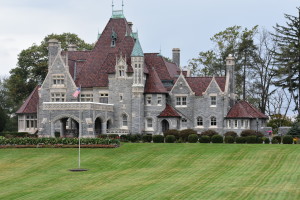Noble Brigham ‘20:
The Main Line has been known for 150 years as the wealthiest suburban Philadelphia area but also has a rich history that most people do not know about. It is centered around the Pennsylvania Railroad (now SEPTA) that gave each town its name. An old article in the Philadelphia Inquirer explained that there was even a mnemonic device to remember the station names: Old Maids Never Wed And Have Babies; Really Vicious Retrievers Snap Willingly, Snarl Dangerously; Beagles Don’t Period. This stands for Overbrook, Merion, Narberth, Wynnewood, Ardmore, Haverford, Bryn Mawr, Rosemont, Villanova, Radnor, St. David’s, Wayne, Strafford, Devon, Berwyn, Daylesford, Paoli.
Lincoln’s inaugural and funeral trains passed through White Hall Station in 1861 and 1865. The railroad station still stands, across from Bryn Mawr Hospital, which has owned it since 1893 and it is now the hospital thrift shop. It was a stop on the Pennsylvania Railroad, but was eliminated in 1871. According to the Main Line Times, it is possible that Lincoln stayed in the White Hall Hotel. By 1912, long after the closure of the station, the hotel had devolved into a tenement, part of the Main Line slums. The White Hall Hotel housed all working class African Americans, just blocks away from large houses and estates occupied by wealthy white families. There was only one sink per floor, and the rooms were rented out individually.
The Bryn Mawr Hotel was built as a resort for the Pennsylvania Railroad in 1890. It was an incentive for people to ride the train out into the suburbs. While it may be strange to think of Bryn Mawr as a town people would vacation in, in those days it would have been much less developed and more picturesque. The hotel even had an annual horse show, the Bryn Mawr Horse Show. The present building is the second hotel, after the original was destroyed in a fire. The second building eventually became The Baldwin School, in 1888.
Ardmore has the first real shopping center in the country. Suburban Square was developed in the late 20’s and early 30’s by the James Kay Company and designed by Dreher and Churchman. It was anchored by Strawbridge and Clothier, and also had an Acme (then called American Stores Company), a bank, a Sunoco, a planned but unbuilt flower shop and a movie theater. The theater was designed by theater architect William Lee who also designed the Bryn Mawr Film Institute (originally was called Seville Theater).
According to PlanPhilly.com, in the 1930’s, Frank Lloyd Wright designed homes in Ardmore, “The Ardmore Experiment” and “The Suntop Homes.” There are four “usonian” style houses. Wright was commissioned by the Tod Company to create small houses on small lots that would be inexpensive to attract young owners. Originally twelve houses were planned, but they ran over budget. This was typical of Frank Lloyd Wright, who had a penchant for expensive materials. Another possible reason why more were not built was that they were begun in 1939, the start of World War II in Europe. Today, they are standout houses in a neighborhood of small postwar cookie cutter houses, but they sell for the same prices as their neighbors.
In 1953 followers of Father Divine, a charismatic religious leader who integrated hotels and businesses during the Depression, bought “Woodmont,” the mansion of steel manufacturer Alan Wood in Gladwyne. Father Divine, an early civil rights pioneer, is believed by followers to be God and moved from New York to Philadelphia in the late 30s.

Photo Courtesy of John Halcovich ’18
The Main Line has had many interesting residents. The real Von Trapp family that The Sound of Music is based off of lived in Merion Station after they escaped Austria. They lived in an extant house on Merion Road from 1939-1943 and reportedly wore traditional lederhosen.
These are just a few of the largely unknown hidden stories that make the Main Line’s rich historic fabric. The Main Line’s history is important because it contributes to our present and in an area rich with history, is everywhere. When someone drives through the small towns named after the train stations, they see historic buildings and the vestiges of the old and great estates. While so much of the history has been destroyed by developers, in the midst of housing developments there are often beautiful residences like the Suntop Homes. One can still shop at Suburban Square, see a movie at the Bryn Mawr Theater, or attend a Holy Communion Banquet at Woodmont.